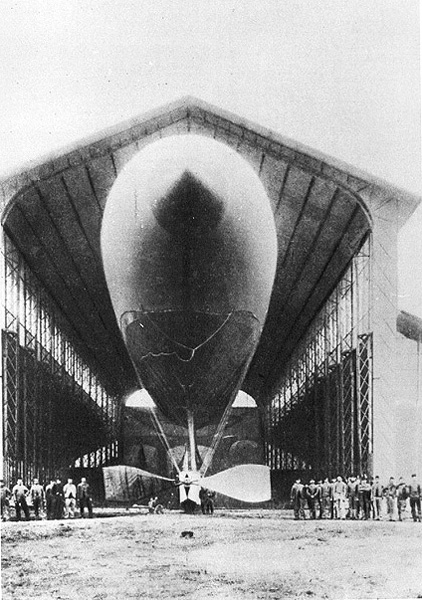ballonet on:
[Wikipedia]
[Google]
[Amazon]
 A ballonet is an air bag inside the outer
A ballonet is an air bag inside the outer
 The ballonet was first described in 1783 by
The ballonet was first described in 1783 by
/ref>
It was not until after Meusnier's death that the first successful application took flight. On 8 August 1884 the first practical airship, ''La France'', flew for the first time.Walker, P.; ''Early Aviation at Farnborough, Vol. I: Balloons, Kites and Airships'', Macdonald (1971), Page 176. Ballonet air valves were originally of a
 A ballonet is an air bag inside the outer
A ballonet is an air bag inside the outer envelope
An envelope is a common packaging item, usually made of thin, flat material. It is designed to contain a flat object, such as a letter or card.
Traditional envelopes are made from sheets of paper cut to one of three shapes: a rhombus, a sh ...
of an airship
An airship or dirigible balloon is a type of aerostat or lighter-than-air aircraft that can navigate through the air under its own power. Aerostats gain their lift from a lifting gas that is less dense than the surrounding air.
In early ...
which, when inflated, reduces the volume available for the lifting gas, making it more dense. Because air is also denser than the lifting gas, inflating the ballonet reduces the overall lift, while deflating it increases lift. In this way, the ballonet can be used to adjust the lift as required.
Ballonets may typically be used in non-rigid or semi-rigid airships, commonly with multiple ballonets located both fore and aft to maintain balance and to control the pitch of the airship.
The image illustrates the principle of a balloon within a balloon. The outer balloon represents the airship's outer envelope or gasbag, while the red inner balloon represents the ballonet. In an airship the ballonet would be much smaller relative to the size of the gasbag; for example, in the French airship Lebaudy Patrie
The Lebaudy ''Patrie'' was a semi-rigid airship built for the French army in Moisson, France, by sugar producers Lebaudy Frères. Designed by Henri Julliot, Lebaudy's chief engineer, the ''Patrie'' was completed in November 1906 and handed ov ...
the volume of the ballonet was approximately one-fifth that of the envelope.
History
 The ballonet was first described in 1783 by
The ballonet was first described in 1783 by Jean Baptiste Meusnier
Jean Baptiste Marie Charles Meusnier de la Place (Tours, 19 June 1754 — le Pont de Cassel, near Mainz, 13 June 1793) was a French mathematician, engineer and Revolutionary general. He is best known for Meusnier's theorem on the curvature o ...
, then a lieutenant in the French Army. However his own airship project was unsuccessful.
In 1784 professor Jacques Charles
Jacques Alexandre César Charles (November 12, 1746 – April 7, 1823) was a French inventor, scientist, mathematician, and balloonist.
Charles wrote almost nothing about mathematics, and most of what has been credited to him was due to mistaking ...
and the Robert brothers
Les Frères Robert were two French brothers. Anne-Jean Robert (1758–1820) and Nicolas-Louis Robert (1760–1820) were the engineers who built the world's first hydrogen balloon for professor Jacques Charles, which flew from central Paris o ...
built an elongated, steerable craft that followed Jean Baptiste Meusnier's proposals. Their design incorporated Meusnier's internal ''ballonnet'' (air cell), a rudder, and oars for propulsion, which proved useless. On July 15 the brothers flew it for 45 minutes from Saint-Cloud
Saint-Cloud () is a commune in the western suburbs of Paris, France, from the centre of Paris. Like other communes of Hauts-de-Seine such as Marnes-la-Coquette, Neuilly-sur-Seine and Vaucresson, Saint-Cloud is one of France's wealthiest tow ...
to Meudon
Meudon () is a municipality in the southwestern suburbs of Paris, France. It is in the département of Hauts-de-Seine. It is located from the center of Paris. The city is known for many historic monuments and some extraordinary trees. One of t ...
accompanied by M. Collin-Hullin and Louis Philippe II, the Duke of Chartres. The absence of a lifting gas release valve meant that the Duke had to slash the envelope
An envelope is a common packaging item, usually made of thin, flat material. It is designed to contain a flat object, such as a letter or card.
Traditional envelopes are made from sheets of paper cut to one of three shapes: a rhombus, a sh ...
to prevent it rupturing when they reached an altitude of about 4,500 metres (15,000 ft).Federal Aviation Administration - F.A.Aviation News, October 2001, Balloon Competitions and Events Around the Globe, Page 15/ref>
It was not until after Meusnier's death that the first successful application took flight. On 8 August 1884 the first practical airship, ''La France'', flew for the first time.Walker, P.; ''Early Aviation at Farnborough, Vol. I: Balloons, Kites and Airships'', Macdonald (1971), Page 176. Ballonet air valves were originally of a
butterfly
Butterflies are insects in the macrolepidopteran clade Rhopalocera from the Order (biology), order Lepidoptera, which also includes moths. Adult butterflies have large, often brightly coloured wings, and conspicuous, fluttering flight. The ...
type, actuated by springs. If pressure rose in the ballonet, a spring would pressure the spindle of the butterfly valve to turn, relieving the pressure. In more recent implementations, the valves are actuated electrically either by a linear actuator
A linear actuator is an actuator that creates motion in a straight line, in contrast to the circular motion of a conventional electric motor. Linear actuators are used in machine tools and industrial machinery, in computer peripherals such as ...
(driven open/closed) or a linear solenoid
upright=1.20, An illustration of a solenoid
upright=1.20, Magnetic field created by a seven-loop solenoid (cross-sectional view) described using field lines
A solenoid () is a type of electromagnet formed by a helix, helical coil of wire whose ...
(spring return), the latter being the favored fail-to-safe arrangement.
References
{{reflist Airship technology